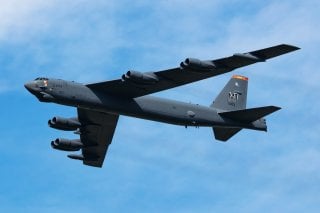Air Force's New B-52J Stratofortress Passes Another Key Milestone
When the new Stratofortress variant is officially introduced to service, it will feature cutting-edge radars, new internal wiring, engine pylons, a digital backbone, and enhanced communications and navigation capabilities
The U.S. Air Force’s latest B-52 variant just reached another milestone. According to the service, the bomber’s F130 engines have passed their critical design review. These engines are expected to play a critical role in the aircraft’s transformation into the B-52J, While the overall program continues to run about three years behind schedule, at least some progress is being made when it comes to the bomber’s power source. The Air Force has been collaborating with Rolls-Royce and Boeing on developing the F130, which represents just one of the many upgrades set to be incorporated into the B-52J.
When the new Stratofortress variant is officially introduced to service, it will feature cutting-edge radars, new internal wiring, engine pylons, a digital backbone, and enhanced communications and navigation capabilities. Progress on the new bomber has been hampered in recent years, however, due to the Air Force “underestimating the level of funding” involved in the program, according to a June Government Accountability Office (GAO) report. The B-52J is not the only upcoming military program to face delays and budgetary constraints. From fighter jets and destroyers to submarine and aircraft carriers, many next-generation weapons systems across the board are facing serious timing issues.
An overview of the new Stratofortress
Once the new B-52J officially enters service with the Air Force, this new variant could ensure that the legendary Stratofortress platform remains in the air for more than 100 years. The long-range, subsonic aircraft was first introduced more than seven decades ago. While its extensive life in service makes the Stratofortress an “old” aircraft, the Air Force is clearly nowhere near ready to push the platform out of service. In fact, the upcoming B-52J upgrades will help the Stratofortress retain an edge over its newer counterparts.
While several key upgrades will be incorporated in the new B-52J overhaul, the addition of the F130 engines will perhaps be the most meaningful. As detailed by Air and Space Forces Magazine, “Any B-52H aircraft modified with the new commercial engines and associated subsystems are designated as B-52J.” The first B-52s ran on Cold War-era Pratt & Whitney TF33 engines. The Air Force will now fit new Rolls Royce-made F130 engines to the B-52Js as part of its Commercial Engine Replacement Program.
Armament-wise, the B-52J will be even more lethal than earlier variants. According to Defense News, the new prototype will be fitted with “everything from gravity bombs that provide ‘affordable mass,’ to cruise missiles for carrying out strikes beyond the range of enemy air defenses, to precision-guided munitions and highly specialized, ‘exquisite’ weapons like hypersonics.” This hypersonic attack cruise missile (HACM) is capable of reaching speeds in excess of Mach 5 (times the speed of sound), making it nearly impossible for adversaries to shoot down.
Although the B-52J appears to be a powerhouse conceptually, the bomber will have to make it past the design and testing phases before it enters service with the Air Force. Considering the ramp-up of geopolitical tensions across the globe, the timely arrival of the new Stratofortress should be prioritized.
About the Author: Maya Carlin
Maya Carlin, National Security Writer with The National Interest, is an analyst with the Center for Security Policy and a former Anna Sobol Levy Fellow at IDC Herzliya in Israel. She has by-lines in many publications, including The National Interest, Jerusalem Post, and Times of Israel.
Image: Soos Jozsef / Shutterstock.com

